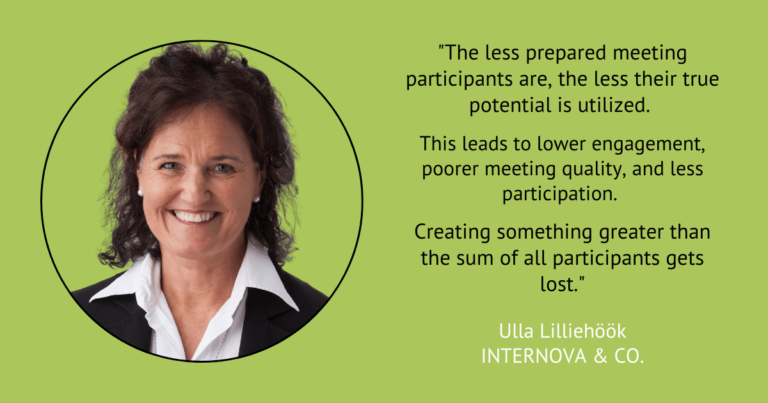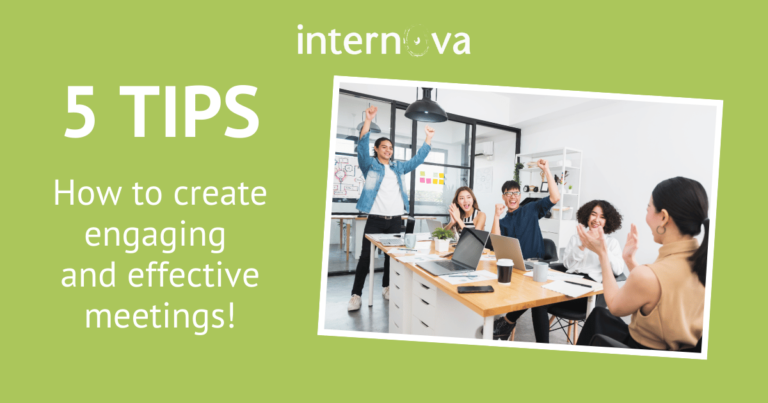Introduction
Many working days mean meetings that follow each other, and if there are gaps between meetings, we handle thousands of tasks simultaneously. We constantly postpone preparations for meetings or do not have time. At meetings, there are many participants who chat and send emails. The time for reflection and time management for new tasks that the meeting led to is minimal. Do you recognise yourself?
Lack of preparation, low meeting engagement, or lack of reflection and development after meetings are unfortunately common. Many of us need to stop and examine ourselves. Ineffective meetings are also costly for the company. Imagine a meeting with 10 participants that lasts 2 hours.
That means 10×2=20 working hours, which in the worst case will be wasted time. It is important that we act to create more effective meetings that engage the participants and are useful. If you are a manager, it is even more important that you act as a meeting role model for your employees and others.
In this blog, you will learn what it takes to create effective meetings as a meeting leader. Such as how to create great engagement among the participants, and how to make them feel involved.
Preparing the meeting participants is essential for effective meetings
When you want to call a new meeting, only you know the content. If your thoughts about the meeting content are unclear at the time of the meeting invitation, there is a great risk that the meeting participants will not receive sufficient information and good conditions in advance.
Because it’s easy to accept meeting requests, which means you’ll probably get 100% acceptance on your meeting invitation (if you’re out in good time). That’s how good you think. Now the meeting is booked, and you leave the meeting thoughts until a few days before the meeting.
This is Absolutely Not Enough!
You probably want a meeting with great commitment from the participants, a great atmosphere, and many wise thoughts.
If the meeting participants do not receive important information in good time and get the participants to prepare, the meeting will not be good. It’s not a meeting participant’s fault – it’s yours.

Two variants of when managers handle the role of meeting leader at a general meeting.
Example 1 – Michael’s approach to preparing and conducting a general meeting
Mikael has sent out meeting invitations with an agenda. He knows the general meeting is in six weeks, but it is so far away that he constantly postpones the preparations. A few days before the meeting, he begins to prepare for the meeting and realises it is more extensive than he thought. He sighs, and the stress increases when he realises there will be a lot of overtime to make it.
Three evenings before the general meeting are dedicated to preparations. When the alarm clock rings on the day of the general meeting, Mikael is extremely tired and has no energy.
At the general meeting, the participants meet a tired boss, and most do not know what the meeting is supposed to be about. The purpose of the meeting is to present positive change and create inspiration, but Mikael does not succeed. The meeting participants, who are supposed to implement what is discussed, lack understanding and motivation, which has devastating consequences after the meeting when all the changes are to be implemented.
After the meeting, Mikael has to spend a lot of time convincing the employees of how important the change is. At the same time, work is underway with all change activities. The result is that the change goals are not achieved within the set deadline.
Example 2 – Johan’s approach to preparing and conducting a general meeting
Johan regularly monitors future activities in his calendar. When he sees the general meeting in six weeks, he books his own planning meeting four weeks before the general meeting. During the planning meeting, he makes an action plan for all activities needed before the general meeting, as well as deadlines for when they must be completed.
First, he thinks, asks himself questions, and writes down everything he needs to do:
- Prepare participants by sending information with the purpose, goals, and agenda of the meeting.
- How can I get participants to prioritise preparation for the meeting? Find some questions and/or an assignment that will be sent to the participants two weeks before the general meeting.
- What information does he need himself? Who should he ask?
- How should the meeting be conducted for the best dynamics (group work, presentations, group energy)?
- How does he get the greatest participation?
- When can he make the presentation?
- Is it appropriate to have other co-managers for some points? What points? Who? Delegate selected items and have pre-meetings with those concerned.
Everything that Johan comes up with that needs to be done is included in his action plan, where each task is given a date when it should be completed.
Schedule times for all tasks
When the action plan is complete, Johan schedules times for all tasks in his calendar as his own meetings. He also books pre-meetings with those responsible for parts of the meeting.
Before the general meeting, the participants are mentally prepared and know the purpose, goals and agenda, and have been given tasks to present and discuss. They are curious about what the meeting will lead to. Johan is an alert meeting leader who creates inspiration and involves all meeting participants with different activities. In addition, there are others who also talk, which creates dynamics. There is a clear process for what happens after the meeting.
The meeting results in motivated participants who want to succeed in their new tasks. The next meeting is in two weeks, and then the goals will be developed. All participants have been given tasks for the meeting for goal development.
The magic of a good meeting is all the work that is done in advance. Bill Russell
Why is Johan’s meeting so good?
It may seem that Johan spends unnecessary time preparing for a meeting. But it makes a big difference already at the meeting. Participants feel involved in the change process from the start. Everyone wants to be part of Johan’s boat of change.
With meeting participants engaged and involved in a change process from the start, the implementation process becomes so much easier. Everyone has happily joined Johan’s boat and wants to be part of the journey. Then the change process will also create so much better results compared to Mikael (example 1).
After the meeting, Mikael has to spend a lot of time persuading those affected to join his boat, instead of spending that time implementing and following up on decided changes. There is a high risk that the deadline for the change work will not be met.
Three Important Aspects for Meeting Leaders to Create Effective Meetings
1 Prepare yourself and the meeting participants well in advance
Plan the meeting content in advance, so everyone can prepare. Meetings such as idea generation, decision-making and strategy development require participants to be well prepared to contribute effectively.
As a meeting leader, you need to plan for and take action that effective meetings require.
Chairperson’s preparations
Goal and purpose of the meeting, Agenda, Tasks/questions for the participants to familiarise themselves with the content and contribute with high quality Plan to reach the meeting goal – enough time? Are more meetings needed?
Participants’ preparations
Read goals and purpose, Read the agenda, Do the tasks. Depending on the context, the answers can be sent to the meeting leader in advance for compilation for the meeting and/or shared with them at the meeting.
2 Create engaged and involved meeting participants
After the goals, purpose and agenda have been presented, it is important to increase the engagement of participants. Ask them to share their thoughts on the questions/tasks they have been given in advance. If there are many participants, beehives (on site) or chat rooms (online) can be used to increase interaction. Feel free to continue the meeting with a mix of your own presentation and interactions, such as asking open-ended questions to vent thoughts and create dialogues.
Summarize the meeting and ensure that all items that require action have a responsible person appointed, and that everyone knows what needs to be done and the deadline for each task or target area.
A manager’s ability to turn meetings into a thinking environment is probably an organisation’s greatest asset. Nancy Kline
3 Follow up on meeting decisions to ensure established measures are implemented
Make sure everyone knows what is expected of them after the meeting by assigning those responsible and following up on the measures regularly. Partly through individual follow-ups and partly in group gatherings.
If there are more complex goals with longer deadlines, it may be appropriate to ask goal managers for action plans with activities and deadlines up to the target date.
Then it becomes clear to you that those responsible know what to do and how to achieve the goals, and that you have a good basis for goal follow-up.
The advantage of goals and action plans is that the manager has to think about how they want to achieve a goal. The manager knows the person in charge is in control. The action plan is also an excellent basis for following up the process up to the target date.

Five Tips how to create Engaging and Effective Meetings!
- Always define goals and purpose
Clarify what the meeting’s goal and purpose are. Why should the meeting be held, and what should we achieve? Include this with the agenda sent out well in advance. - An agenda is available and sent out well in advance
A clear agenda helps everyone be focused and prepared. Set start and end times for each point to ensure that each point is kept within its time frame. If some item takes longer than planned, maybe an extra meeting needs to be booked for that topic. - Get meeting participants to prepare in advance
Send two to three questions with the agenda to increase meeting quality. Prepared participants contribute with better ideas and dialogues. In addition, it becomes significantly easier to get further in the dialogues at the meeting with the help of follow-up questions and deeper dialogues/discussions.
- The meeting leader allows participants to interact
Mix presentations with conversations, and use breakout rooms, group work, or beehives to increase interaction. Short presentations, open questions, and a lot of dialogue create commitment and participation. - Plan for the important follow-up
Summarize the meeting and make sure everyone knows who is responsible for what and when it should be done. After the meeting, clear meeting notes and an activity list with a designated person responsible for each activity are sent.
Finish
I hope you have gained some new insights into and increased understanding of the importance of preparing meetings well in advance, as well as the importance of creating great commitment and participation. Now it may be time to reflect on how you want to create your effective meetings as a meeting leader.
Choose a few changes, and then continue with more as changes become new habits. Instead of coming up with improvements yourself, you can advantageously involve meeting participants/employees. By thinking and coming up with ideas together, you get better ideas because there are more of you, and simultaneously you create the famous participation. Then, when you have your meetings, it will be easier to improve them, because everyone knows what you want to improve and what you can do to succeed.
More knowledge about effective meetings?
eller or your company's development need!


